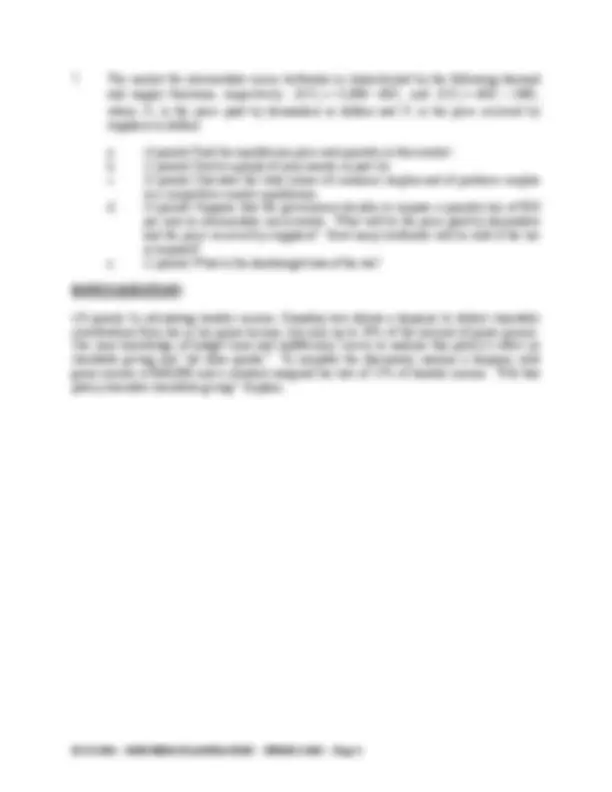



Study with the several resources on Docsity

Earn points by helping other students or get them with a premium plan


Prepare for your exams
Study with the several resources on Docsity

Earn points to download
Earn points by helping other students or get them with a premium plan
Community
Ask the community for help and clear up your study doubts
Discover the best universities in your country according to Docsity users
Free resources
Download our free guides on studying techniques, anxiety management strategies, and thesis advice from Docsity tutors
Material Type: Exam; Professor: North; Class: Intermediate Microeconomic Analysis; Subject: Economics; University: Baylor University; Term: Spring 2005;
Typology: Exams
1 / 3

This page cannot be seen from the preview
Don't miss anything!


ECO 3306 Name: Spring 2005 Dr. Charles M. North
MIDTERM EXAMINATION
Answer all questions in your bluebook. SHOW ALL WORK! Only answers showing work will receive any credit, partial or full. This examination is worth 100 points, all of which must be earned.
a. (1 point) Derive the consumer’s marginal rate of substitution as a function of x 1 and x (^) 2. b. (2 points) Write down another utility function that represents the same preferences. Prove that your utility function has the same marginal rate of substitution that you found in part (a). c. (10 points) Find the consumer’s generalized demand functions for goods 1 and 2, x 1 (^) * ( p 1 , p 2 , m )and x (^) 2 * ( p 1 , p 2 , m ). d. (1 point) What is the consumer’s optimal bundle if ( p 1 (^) , p 2 , m )=( 5 , 4 , 300 )? e. (10 points) Suppose that the price of good 2 goes up to p 2 ′ (^) = 5 , while p 1 and m remain at the same levels as in part (d). Calculate the substitution and income effects of the price change on consumption of good 2. f. (4 points) Sketch a graph of your answer to part (e), and label it completely.
a. (3 points) What is the consumer’s optimal bundle if ( p 1 (^) , p 2 , m )=( 9 , 3 , 81 )? b. (3 points) What is the consumer’s optimal bundle if ( p 1 ′ , p 2 , m )=( 3 , 3 , 81 )? c. (4 points) Calculate the substitution and income effects of the change in the price of good 1 from part (a) to part (b). Explain.
a. (8 points) Find the consumer’s generalized demand functions for good 1 and 2, x 1 (^) * ( p 1 , p 2 , m )and x (^) 2 * ( p 1 , p 2 , m ). b. (4 points) Are these preferences homothetic? Explain.
Both women have been practicing their kicking, and on average each woman makes 40% of the 30-yard field goals she attempts. Millicent’s risk preferences are represented by the von Neumann-Morgenstern utility function v ( ci )= c^1 i /^2 , where c (^) i is the amount of money she wins in the contest. In contrast, Gertrude’s risk preferences are represented by the von Neumann-Morgenstern utility function v ( ci )= ci^2 /^3.
a. (2 points) Find each woman’s expected utility. b. (6 points) For each woman, find the minimum amount of money she would have to be paid to give up the chance to kick the field goal. c. (2 points) Suppose that the right to attempt the field goal could be sold. Would either woman be willing to purchase the other’s field goal attempt? If so, which one, and what is the range of prices at which a voluntary sale could be made? Explain.
a. (4 points) What is the total market demand function that combines demand for both city dwellers and suburbanites?
function of P , the price charged to all dinner attendees. c. (2 points) In the past, the charity has set P = $40. What is the price elasticity of demand at this price? Assuming the charity seeks to maximize the revenue generated by the dinner, how do you know that P = $40 is not optimal? d. (5 points) Assuming that the charity seeks to maximize revenue from the dinner, find the optimal price to charge all attendees.